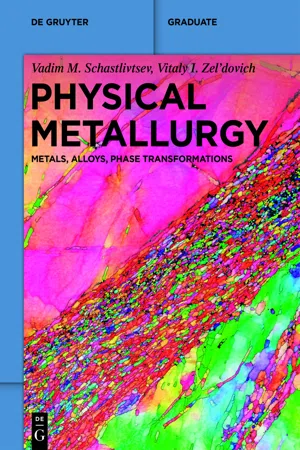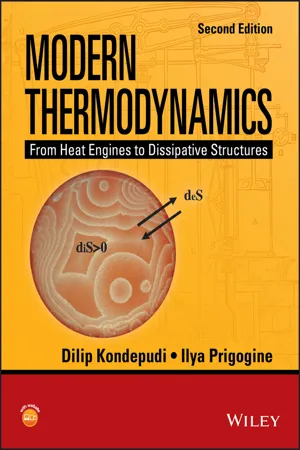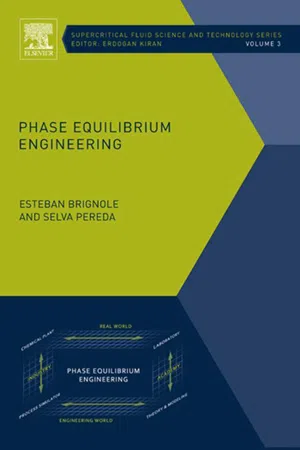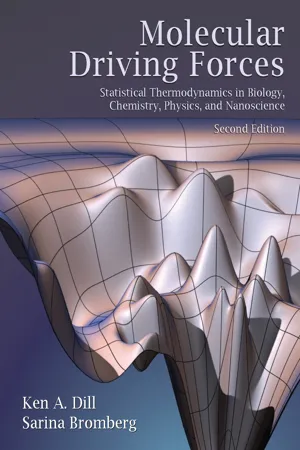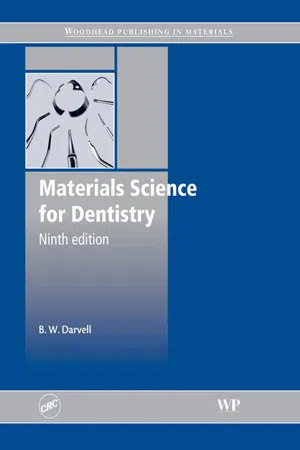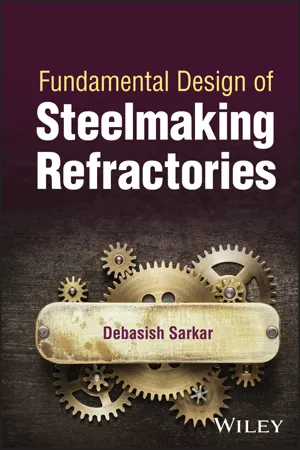Technology & Engineering
Phase Diagram
A phase diagram is a graphical representation of the states of matter (solid, liquid, gas) of a substance under varying conditions of temperature and pressure. It shows the boundaries between these states and the points at which phase transitions occur. Phase diagrams are essential in understanding the behavior of materials and are widely used in engineering and technology for designing and controlling processes involving phase changes.
Written by Perlego with AI-assistance
Related key terms
Related key terms
1 of 4
Related key terms
1 of 3
10 Key excerpts on "Phase Diagram"
- eBook - ePub
Materials Selection for Design and Manufacturing
Theory and Practice
- Joseph Datsko(Author)
- 2020(Publication Date)
- CRC Press(Publisher)
Chapter 3EQUILIBRIUM Phase DiagramS
INTRODUCTION
Equilibrium Phase Diagrams are graphs that indicate which phases exist at any specific combination of temperature, pressure, and composition for a given material. They are one of the most important tools that an engineer has available to determine how a given material can be treated to achieve the best mechanical properties. They are a vital guide to the proper selection and specification of metals. The term “equilibrium” in this context means that the material is held at the higher temperatures for a sufficiently long time for it to change to its most stable condition at that temperature. And any subsequent cooling is done sufficiently slowly for the material to change to its most stable condition at each lower temperature. In practice, furnace cooling is considered to be slow enough to form the equilibrium phase.Phase Diagrams are classified as unary, binary, ternary, etc., on the basis of the number of pure components involved. Representative Phase Diagrams are shown in Figure 3–1 . A unary diagram, consisting of only one component (an element or compound), has temperature and pressure as the two axes and three intersecting lines that divide the graph into three areas; one for each of the three phases, which in this case are the three states of matter (solid, liquid, and gas). The point where the three phases can coexist is called the triple point Binary Phase Diagrams are by far the ones most commonly used and they are discussed in detail later in this chapter. They have composition and temperature as the two axes, as shown in Figure 3 (b). A ternary diagram is made up of three compositions; each side of an equilateral triangle gives the percentage of one of the components as shown in Figure 3–1 (c). A vertex of the diagram represents 100% of the component designated at the vertex. The side of the diagram opposite that particular vertex represents 0% of that component. Thus, point P in Figure 3–1 - eBook - ePub
- Anthony R. West(Author)
- 2014(Publication Date)
- Wiley(Publisher)
7 Phase Diagrams and their InterpretationPhase Diagrams summarise in graphical form the ranges of temperature (and sometimes pressure) and composition over which phases or mixtures of phases are stable under conditions of thermodynamic equilibrium. They therefore contain information on the compositions of compounds and solid solution series, phase transitions and melting or decomposition temperatures. For inorganic solids that have practical or potential applications, it is vital to know whether they are stable in contact with their environment and whether they react or transform into another solid(s) during use. Thus, Phase Diagrams have been key to the use and development of inorganic materials in technologies such as glass, refractories, cement and ceramics. This applies not only to the conditions under which these materials are used but also to their synthesis and fabrication.Phase Diagrams tell us the final equilibrium products of a particular reaction, although they give no information on reaction kinetics. Nevertheless, it can be useful to know in which direction a reaction should proceed or whether a particular reaction product has reached equilibrium. Knowledge of an equilibrium Phase Diagram enables us to understand the effects of temperature, pressure and composition on reaction conditions. If Phase Diagram information is unavailable, for instance, if we have prepared a new material for the first time, we may wish to start collecting information that would enable us to construct a Phase Diagram and devise tests to establish whether or not a reaction is complete. The main purpose of this chapter is to explain the use and interpretation of Phase Diagrams. In the last section, some guidelines for constructing new Phase Diagrams are given.The fundamental rule upon which Phase Diagrams are based is the phase rule - eBook - ePub
Physical Metallurgy
Metals, Alloys, Phase Transformations
- Vadim M. Schastlivtsev, Vitaly I. Zel'dovich(Authors)
- 2022(Publication Date)
- De Gruyter(Publisher)
Chapter 2 Phase DiagramsPhase Diagrams play an important role in physical metallurgy. They serve as the basis for analyzing phase transformations and forming the structure of alloys when changing their chemical composition, temperature, and pressure. Let us first resort to definitions of the concepts used further in this chapter. An alloy is referred to as a mixture obtained by fusing two or more elements where at least one of them is metal. Components are called chemically individual substances combined into an alloy. Components can be both elements and chemical compounds. A phase is the homogeneous part (solid and liquid) of an alloy, isolated from another parts by a separation surface demarcating discontinuous change in alloy properties. In real alloys, the phase includes a set of homogeneous alloy parts having a separation surface (interphase boundaries). Equilibrium of the phases is reached when there are no visible transformations in an alloy. In other words and more precisely, an alloy is in a state of thermodynamic equilibrium if its state parameters (temperature, pressure, and concentration) do not change over time and if there are no fluxes of any type. From a microscopic point of view, such a state is a state of dynamic (mobile) equilibrium. A Phase Diagram involves a graphic representation of the equilibrium states of the phases in the system of a given group of alloys.2.1 The phase rule
The conditions of equilibrium of the phases in an alloy are satisfied when chemical potentials of each component in any of the phases are said to be equal. If a given component in one phase has the chemical potential greater than in the other phase, it passes to a phase with lower chemical potential. The condition of minimum thermodynamic potential dictates the equality of the chemical potentials of each component in all phases being in equilibrium. Let k - eBook - ePub
Modern Thermodynamics
From Heat Engines to Dissipative Structures
- Dilip Kondepudi, Ilya Prigogine(Authors)
- 2014(Publication Date)
- Wiley(Publisher)
Under suitable conditions, the phases of a compound can coexist in a state of thermal equilibrium. The nature of this state of thermal equilibrium and how it changes with pressure and temperature can be understood using the laws of thermodynamics. In addition, at the point where the phase transition takes place, some thermodynamic quantities, such as molar entropy, change discontinuously. Based on such discontinuous changes of some thermodynamic quantities, such as molar heat capacity and molar entropy, phase transitions in various materials can be classified into different ‘orders’. There are general theories that describe phase transitions of each order. The study of phase transitions has grown to be a large and interesting subject, and some very important developments occurred during the 1960s and the 1970s. In this chapter, we will only present some of the basic results. For further understanding of phase transitions, we refer the reader to books devoted to this subject [1–3].7.1 Phase Equilibrium and Phase Diagrams
The conditions of temperature and pressure under which a substance exists in different phases, i.e. gas, liquid or solid, are summarized in a Phase Diagram. A simple Phase Diagram is shown in Figure 7.1 . Under suitable conditions of pressure and temperature, two phases may coexist in thermodynamic equilibrium. The thermodynamic study of phase equilibrium leads to many interesting and useful results. For example, it tells us how the boiling point or freezing point of a substance changes with changes in pressure. We shall see how the thermodynamic formalism developed in the previous chapters enables us to obtain expression that relates the boiling point of a liquid to its pressure.Figure 7.1(a) Phase Diagram for a one-component system showing equilibrium p–T curves (defined by the equality of the chemical potentials), the triple point T and the critical point C. Tc is the critical temperature above which the gas cannot be liquefied by increasing the pressure. (b) A liquid in equilibrium with its vapor. The affinity for the liquid–vapor transformation A = μl – μg = 0. An infinitely slow expansion in the system's volume results is a ‘reversible’ transformation of the liquid to gas at an affinity A ≈ 0.We begin by looking at the equilibrium between liquid and gas phases, as shown in Figure 7.1b . When a liquid is in a closed container, a part of it will evaporate and fill the space above it until an equilibrium is reached. The system under consideration is closed and consists only of the liquid in equilibrium with its vapor at a fixed temperature. In Figure 7.2 , the p–V isotherms of a vapor–liquid system are shown. The region of coexistence of the liquid and vapor phases corresponds to the flat portion XY of the isotherms. When T > Tc , the flat portion does not exist; there is no distinction between the gas and the liquid phases. The flat portion of each isotherm in Figure 7.2 corresponds to a point on the curve TC in Figure 7.1 a; as the temperature approaches Tc - eBook - ePub
- S Seetharaman(Author)
- 2005(Publication Date)
- Woodhead Publishing(Publisher)
3Phase Diagrams, phase transformations, and the prediction of metal properties
K. Morita The University of TokyoN. Sano Nippon Steel Corporation, Japan3.1 Introduction
Phase Diagrams provide a variety of thermodynamic information through equilibria among multiple phases as well as quantitative data on phase distribution in a specific system. Phase relations demonstrate that any chemical potentials of all coexisting phases are identical, imposing significant restrictions in the thermodynamic properties of the probable phases. By solving these restrictions, with simultaneous equations, the variables of compositions can be determined as a function of temperature. Nowadays, a number of Phase Diagrams are drawn by thermodynamic calculations by commercial PC programs using empirical parameters within some constraint. Although Phase Diagrams show the phase relations quantitatively by lever rules, an average composition in a multi-phase region shows no difference in chemical potentials, while sometimes there is uncertainty in the chemical potential of a single stoichiometric compound. For instance, an intermetallic compound AB has two different chemical potentials at A deficient side and B deficient side. Strictly speaking, an abrupt gap of each chemical potential should be considered at that composition. In the present chapter, Phase Diagrams are discussed from the aspect of thermodynamic stability. By further investigation of chemical potential diagrams, their conversion to Phase Diagrams is used to compare the difference in the physical meanings.On the other hand, it is important to understand the behaviour of phase transformation as well as phase relations and their phase stability in any metallurgical process. As a primary step, expression and interpretation of ternary Phase Diagrams are introduced, and then the fundamental features of the diagrams are discussed from thermodynamic aspects. As the easiest way in viewing a three-dimensional Phase Diagram, just a number of compiled isothermal sections representing various phase relations are shown. Finally, solidification behaviour is described as an example of practical application of the ternary Phase Diagrams. - eBook - ePub
- David A. Porter, Kenneth E. Easterling, Mohamed Y. Sherif(Authors)
- 2021(Publication Date)
- CRC Press(Publisher)
1 Thermodynamics and Phase DiagramsDOI: 10.1201/9781003011804-1This chapter deals with some of the basic thermodynamic concepts that are required for a more fundamental appreciation of Phase Diagrams and phase transformations. It is assumed that the student is already acquainted with elementary thermodynamics and only a summary of the most important results as regards phase transformations will be given here. Fuller treatments can be found in the books listed in the bibliography at the end of this chapter.The main use of thermodynamics in physical metallurgy is in the prediction of equilibrium conditions in an alloy. In considering phase transformations we are always concerned with changes towards equilibrium, and thermodynamics is therefore a very powerful tool; it can allow the calculation of the driving force for the transformation, and the conditions that exist locally at interfaces before equilibrium is reached throughout the system.1.1 EQUILIBRIUM
It is useful to begin this chapter on thermodynamics by defining a few of the terms that will be frequently used. In the study of phase transformations, we will be dealing with the changes that can occur within a given system , e.g., an alloy that can exist as a mixture of one or more phases. A phase can be defined as a portion of the system whose properties and composition are homogeneous and which is physically distinct from other parts of the system. The components of a given system are the different elements or chemical compounds which make up the system, and the composition of a phase or the system can be described by giving the relative amounts of each component.The study of phase transformations, as the name suggests, is concerned with how one or more phases in an alloy (the system) change into a new phase or mixture of phases. The reason why a transformation occurs at all is because the initial state of the alloy is unstable relative to the final state. But how is phase stability measured? The answer to this question is provided by thermodynamics. For transformations that occur at constant temperature and pressure, the relative stability of a system is determined by its Gibbs free energy( G ) - eBook - ePub
- Esteban Alberto Brignole, Selva Pereda(Authors)
- 2013(Publication Date)
- Elsevier(Publisher)
Chapter 3Phase Equilibrium Diagrams
Esteban Brignole and Selva PeredaAbstract
Phase equilibrium knowledge is required for the design of all sorts of chemical processes that may involve separations, reactions, fluids flow, particle micronization, etc. Indeed, different phase behavior scenarios are required for a rational conceptual process design. The aim of this chapter is to present the possible fluid mixture phase behavior that can be found in binary, ternary, and multicomponent systems. Moreover, representation of phase behavior in terms of Phase Diagrams is discussed. Dealing with Phase Diagrams of complex mixtures is not an easy task for beginners; however, very simple concepts are behind the rules for their construction. Phase Diagrams are essential tools for phase equilibrium engineering as they provide valuable hints to understand the process and to assess the feasible and optimum operating regions. In this chapter, the “phenomenological” meaning of each phase behavior and its relation with molecular properties is discussed. A special attention is given to binary system phase behavior. Even though, in practice we rarely found such simple mixtures, they furnish a great deal of information for the understanding of multicomponent systems.Keywords
Phase Diagrams; Classification; Binary mixtures; Univariant lines; Gibbs diagrams; Phase envelopesPhase equilibrium knowledge is required for the design of all sorts of chemical processes: separations, reactions, fluid flow, particle micronization, etc. Indeed, different phase behavior scenarios are required for a rational conceptual process design. The aim of this chapter is to present the possible fluid mixtures’ phase behavior that can be found in binary, ternary, and multicomponent systems. Moreover, we discuss its representation in Phase Diagrams. Dealing with Phase Diagrams of complex mixtures is not an easy task for beginners; however, very simple concepts are behind the rules for their construction. Phase Diagrams are essential tools for phase equilibrium engineering (PEE); you can find in them important hints to understand the process and the feasible and optimum operating regions. In this chapter, we discuss the “phenomenological” meaning of each behavior and its relation with molecular properties, while Chapters 4 (models) and 5 (algorithms) deal with the mathematical formulation required for their calculation. For both approaches, either “physical” or “mathematical” is important to understand that “a Phase Diagram is not an isolated picture but a snapshot of phase behavior with pressure, temperature and composition coordinates”, quoting Swaan Arons and de Loos [1] - eBook - ePub
Molecular Driving Forces
Statistical Thermodynamics in Biology, Chemistry, Physics, and Nanoscience
- Ken Dill, Sarina Bromberg(Authors)
- 2010(Publication Date)
- Garland Science(Publisher)
25.4 ). In this case, the two control variables are the temperature and composition (concentration of one of the components).Liquids or Solids May Mix at High Temperatures but Not at Low TemperaturesSometimes water and oil don’t mix. But, sometimes they do. Figure 25.4 gives the Phase Diagram. Let’s follow the type of experiment that creates this diagram. Make six solutions, numbered 1 to 6, having different compositions of oil and water. Beaker 1 has mostly water and a little oil. Beaker 6 has mostly oil and a little water. All of the solutions are at the same temperature T0 . The vertical axes of Figures 25.3 and 25.4 represent the temperatures of the solutions, and the horizontal axes represent the B concentrations xB of those solutions. If B in Figure 25.3 is oil and A is water, xB represents the mole fraction of the oil in the water. The left end of the horizontal axis (xB = 0) represents pure water and the right end (xB = 1) represents pure oil.1. A small amount of oil dissolved in water. Test tube 1 has only a small amount of oil in a large volume of water. The oil fully dissolves in the water, meaning that most of the individual oil molecules are dispersed and surrounded by water molecules. This is called a single-phase solution.Figure 25.3 Six different solutions help to map out the Phase Diagram. T0 is the temperature of the solution, x′ is the concentration of B that saturates liquid A, and x″ is the concentration of B at which A saturates B. Tc is the critical temperature.Figure 25.4 A Phase Diagram for liquid benzene (mole fraction x) in perfluoroheptane. Source: JN Murrell and AD Jenkins, Properties of Liquids and Solutions, Wiley, New York, 1982. Data are from JH Hildebrand, BB Fisher, and HA Benesi, J Am Chem Soc 72 - eBook - ePub
- B W Darvell(Author)
- 2009(Publication Date)
- Woodhead Publishing(Publisher)
Chapter 8Composition and Phase Diagrams
Pure materials are infrequently used in dentistry because they rarely offer the properties required . Mixtures of two or more substances are therefore generally encountered . It is necessary therefore to be able to relate properties to composition in terms of the mixtures . This would lead to difficulties of data management if only the enumeration of all relevant properties for all possible mixtures of all relevant substances were attempted . Means must be found to reduce the scale of the problem and facilitate exploration and comprehension of the effects of the mixtures .The first concern is to make a map of the range of compositions available for a given set of ingredients. This can be done on an elementary geometrical basis on a line for two ingredients and in a triangle for three .The meanings of terms such as state,phase and component must be established.Whenever a reaction is involved , it is necessary to enquire what the equilibrium condition is towards which the system tends to move , that is ,we enquire about its thermodynamics. This is also true when we deal with systems such as alloys - eBook - ePub
- Debasish Sarkar(Author)
- 2023(Publication Date)
- Wiley(Publisher)
2 Equilibrium and Nonequilibrium Phases2.1 Introduction
A Phase Diagram study is mandated to synchronize material formation at a specific temperature, pressure, and composition. Several experimental data represent the temperature and composition limits of two or more stable constituents at different phases. Efficient heat distribution in a kiln or furnace can facilitate the desired equilibrium phase during refractory manufacturing, eventually fulfilling steel industry demand. However, any nonfavorable conditions may develop nonequilibrium phases that reduce refractory performance. For example, high-temperature refractory–slag interaction expedites the glassy phase during the steelmaking process.There are multiple binary and tertiary equilibrium phases from refractory compositions and slag chemistry, and significant phases are represented in Figure 2.1 . Not all phases are formed in one product or single contact zone; instead, these are often in a wide span of refractory products and steel processing starting from BOF to Tundish operation. Some essential and valuable explanations from the perspective of the ceramic systems are summarized to analyze the failure of refractories. Despite these combinations, there are also possibilities to form several phases in the presence of other oxides or different mixtures of oxides; such incidences are discussed in relevant chapters as required.Major working lining refractory crystals are in the light shade zone; relatively low melting impurities in the dark shade zone either present in refractory or interact with slag in the steelmaking process. Binary phases either exist in refractory products or are formed in the steelmaking process. The effect of impurities on the refractory is represented as tertiary phases.Figure 2.12.2 Basics of Phase Diagram
2.2.1 Gibb’s Phase Rule
In an equilibrium condition at uniform temperature and pressure, each constituent’s vapor pressure or chemical potential remains the same in all phases. If the temperature or pressure is altered, there is a tendency to heat or mass transfer in the system. In consideration of equilibrium condition, Gibb’s phase rule states that the number of phases P, number of variance F, number of components C, and follows a relationship as Equation (2.1
Index pages curate the most relevant extracts from our library of academic textbooks. They’ve been created using an in-house natural language model (NLM), each adding context and meaning to key research topics.
Explore more topic indexes
Explore more topic indexes
1 of 6
Explore more topic indexes
1 of 4


